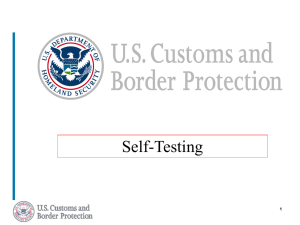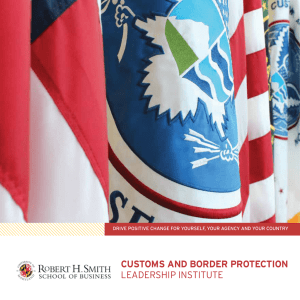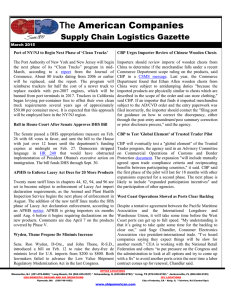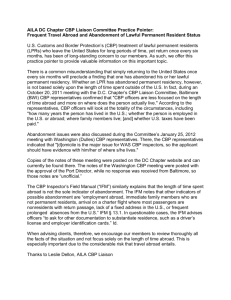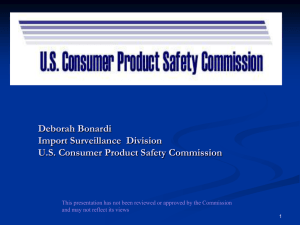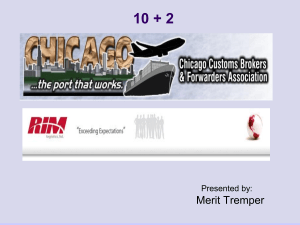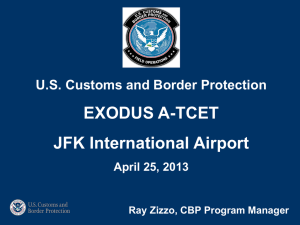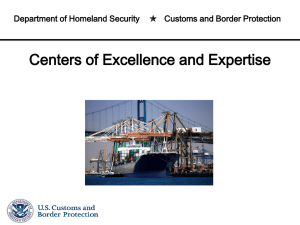United States Electronic Signatures in a US Customs
advertisement
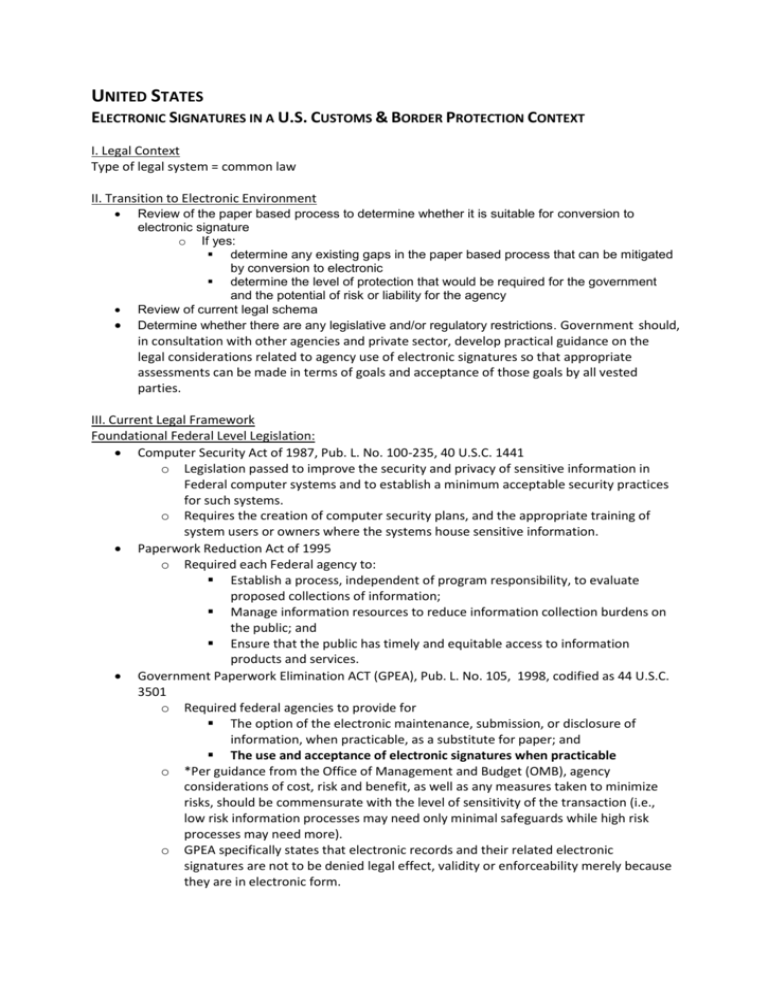
UNITED STATES ELECTRONIC SIGNATURES IN A U.S. CUSTOMS & BORDER PROTECTION CONTEXT I. Legal Context Type of legal system = common law II. Transition to Electronic Environment Review of the paper based process to determine whether it is suitable for conversion to electronic signature o If yes: determine any existing gaps in the paper based process that can be mitigated by conversion to electronic determine the level of protection that would be required for the government and the potential of risk or liability for the agency Review of current legal schema Determine whether there are any legislative and/or regulatory restrictions. Government should, in consultation with other agencies and private sector, develop practical guidance on the legal considerations related to agency use of electronic signatures so that appropriate assessments can be made in terms of goals and acceptance of those goals by all vested parties. III. Current Legal Framework Foundational Federal Level Legislation: Computer Security Act of 1987, Pub. L. No. 100-235, 40 U.S.C. 1441 o Legislation passed to improve the security and privacy of sensitive information in Federal computer systems and to establish a minimum acceptable security practices for such systems. o Requires the creation of computer security plans, and the appropriate training of system users or owners where the systems house sensitive information. Paperwork Reduction Act of 1995 o Required each Federal agency to: Establish a process, independent of program responsibility, to evaluate proposed collections of information; Manage information resources to reduce information collection burdens on the public; and Ensure that the public has timely and equitable access to information products and services. Government Paperwork Elimination ACT (GPEA), Pub. L. No. 105, 1998, codified as 44 U.S.C. 3501 o Required federal agencies to provide for The option of the electronic maintenance, submission, or disclosure of information, when practicable, as a substitute for paper; and The use and acceptance of electronic signatures when practicable o *Per guidance from the Office of Management and Budget (OMB), agency considerations of cost, risk and benefit, as well as any measures taken to minimize risks, should be commensurate with the level of sensitivity of the transaction (i.e., low risk information processes may need only minimal safeguards while high risk processes may need more). o GPEA specifically states that electronic records and their related electronic signatures are not to be denied legal effect, validity or enforceability merely because they are in electronic form. o Federal governments are encouraged to use a range of electronic signatures alternatives. o As defined by GPEA, an electronic signature is a method of signing an electronic message that Identifies and authenticates a particular person as the source of the electronic message; and Indicates such person’s approval of the information contained in the electronic message (i.e., “intent”) Electronic Records and Signatures in Global and National Commerce Act (E-SIGN), Pub. L. 106-229, 2000, 15 U.S.C. 7001 o E-SIGN eliminates legal barriers to the use of electronic technology to form and sign contracts, collect and store documents, and send and receive notices and disclosures o E-SIGN applies broadly to Federal and state statutes and regulations governing private sector activities. o Laws and regulations that are primarily governmental and do not relate to business, commercial or consumer transactions are not within the scope of this legislation; they are instead addressed by the Government Paperwork Elimination Act. o * Certain laws and regulations involve both GPEA and E-SIGN, especially with respect to record retention requirements in agency regulations that govern business, consumer and commercial transactions. U.S. Customs and Border Protection Specific Empowering Legislation: Customs Modernization Act (the “Mod Act”), Pub. L. 103-182, December 8, 1993, amending title 19 U.S.C. 1508, 1509 and 1510, formally Title VI of the North American Free Trade Agreement Implementation o One of the most sweeping regulatory reform legislations, amending the Tariff Act of 1930 and related laws. o Introduced two new Customs concepts known as "informed compliance" and "shared responsibility." These concepts are premised on the idea that in order to maximize voluntary compliance with Customs laws and regulations, the trade community needs to be clearly and completely informed of its legal obligations. o An overarching goal of the Mod Act was to place a greater responsibility upon the trade community to exercise “reasonable care” in complying with import requirements. The principal section of the Mod Act addressing automation was codified under 19 U.S.C. 1411-1414 (promulgated by CBP under the National Customs Automation Program (NCAP) testing provision, 19 CFR 101.9). o NCAP provides U.S. Customs and Border Protection with an automated electronic system to process commercial importations and facilitate business improvements with the trade community. o The Mod Act amended Section 484 of the Tariff Act of 1930. Added provision (d)(1) providing that: Entries shall be signed by the importer of record, or his agent, unless filed pursuant to an electronic data interchange system. If electronically filed, each transmission of data shall be certified by an importer of record or his agent, one of whom shall be resident in the United States for purposes of receiving service of process, as being true and correct to the best of his knowledge and belief, and such transmission shall be binding in the same manner and to the same extent as a signed document. The entry shall set forth such facts in regard to the importation as the Secretary may require and shall be accompanied by such invoices, bills of lading, certificates, and documents, or their electronically submitted equivalents, as are required by regulation. The Mod Act was subsequently amended by the Trade Act of 2002 to include, among other things, the following change (2002—Subsec. (b). Pub. L. 107–210)1: o Struck out a former second sentence which read as follows: “Participation in the Program is voluntary.” o Inserted a new second sentence which now reads: The Secretary may, by regulation, require the electronic submission of information described in subsection (a)… Security and Accountability for Every Port Act of 2006 (P.L. 109-347 (Section 405), October 13, 2006) (SAFE Port Act) o Required the Secretary of the Treasury to oversee an interagency initiative to establish a “single portal system,” to be known as the” International Trade Data System” (ITDS) and to be operated by the United States Customs and Border Protection. This unified data system is to electronically collect and distribute import and export data required by government agencies that license or clear the import or export of goods. IV. Practical Applications of the Legislative Framework and Resulting Implementation of the Automated Commercial Environment (ACE) Portal: The ACE Secure Data Portal is a web-based capability providing a single, centralized online access point to connect CBP, the trade community and government agencies. Once a Portal Account is established, trade members can electronically submit specified documentation/forms needed during the cargo importation process. All ACE Accounts must have a designated Account Owner who must submit to CBP a completed “signed” ACE Application as proof of their designation as Account Owner for the Account. The “signature” can be digital. This document must also be signed by the Principal (any high ranking officer within the company structure) ACE authenticates the electronic documents that it receives by comparing certain fields in the message to a user profile established at the time of registration. The profile includes, among other things, both the filer code and password chosen by the filer. This “trusted” profile is used during authentication (Port, Filer Code, password). EDI data-transmissions (through ABI – Automated Broker Interface, for example): • Another method by which trade members can submit data to CBP. To use ABI, a brokerage or importer must request or already possess a “filer code.” This request is made in writing by a licensed broker or importer and is normally signed by the officer of the company. CBP will accept this application by mail, facsimile, or as scanned image file such as PDF. Only originally signed hard copies are acceptable. • Once a filer code has been issued, the brokerage/importer must submit a Letter of Intent indicating intent to transmit data via EDI. The Letter of Intent must be on company letter head, signed by the officer of the company and provide a description of the trading partner’s current or planned hardware, data communications, and entry processing system; and information regarding the brokerage/importer and the entries they expect to make through the system. CBP will accept this application by mail, facsimile, or as scanned image file such as PDF. (Note: CBP is currently exploring developing an automated utility to replace the hard copy letter of intent). • Any party transmitting data with CBP must also sign an Interconnection Security Agreement (ISA). This agreement requires acknowledgment by the signatory that: both CBP and the signatory are expected to protect the data in accordance with the Privacy Act, Trade Secrets Act (18 U.S. Code 1905), and Unauthorized Access Act (18 U.S. Code 2701 & 2710); they are aware of the sensitivity of all data filed is Sensitive But Unclassified (SBU); that all CBP employees with access to the data are U. S. citizens with a valid and current CBP Background 1 http://www.law.cornell.edu/usc-cgi/get_external.cgi?type=pubL&target=107-210 (as of April 2013) • Investigation; they are aware of the policy documents that govern the protection of the data (CBP 1400-05D Security Policy Handbook and Department of Homeland Security 4300A Security Policy Handbook); and that CBP maintains an audit trail and employs intrusion detection measures to maintain security and system integrity. Data is transmitted using a Virtual Private Network (VPN), a means of communication from one computer to another over a public telecommunications network that relies on encryption to secure the content of transmissions.
